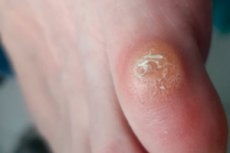Medical expert of the article
New publications
Hard calluses in adults and children
Last reviewed: 05.07.2025

All iLive content is medically reviewed or fact checked to ensure as much factual accuracy as possible.
We have strict sourcing guidelines and only link to reputable media sites, academic research institutions and, whenever possible, medically peer reviewed studies. Note that the numbers in parentheses ([1], [2], etc.) are clickable links to these studies.
If you feel that any of our content is inaccurate, out-of-date, or otherwise questionable, please select it and press Ctrl + Enter.

As is known, calluses are divided into wet (moist) and dry (hard). Thus, a hard callus is a thickening of the outer (horny) layer of the epidermis, consisting of dead keratinocytes - this is a dry callus. [ 1 ]
Causes of Formation of Hard Callus
Wherever a hard callus forms - on the foot, on the heel, on the toe,
Between the fingers, on the hand, its causes are associated with constant friction and pressure (mechanical load) on the skin area, which leads to its thickening due to increased keratinization. And this, in fact, is a dry hard callus.
And a hard core callus is a classic core callus.
Risk factors
Risk factors (tight shoes, flat feet, excess body weight) and the mechanism of formation of hard calluses - pathogenesis, main symptoms, possible consequences and complications, as well as diagnostics are discussed in detail in the publications:
Who to contact?
How to get rid of hard calluses?
Treatment of hard (dry) calluses is carried out using various keratolytic agents for hard calluses. [ 2 ] More details about this in the articles:
Also read:

